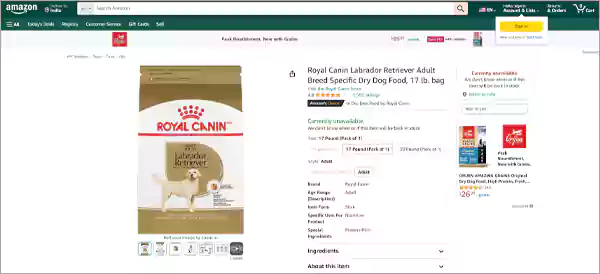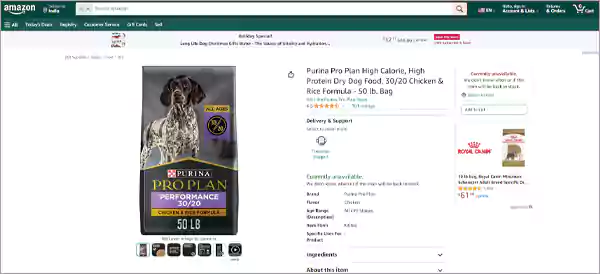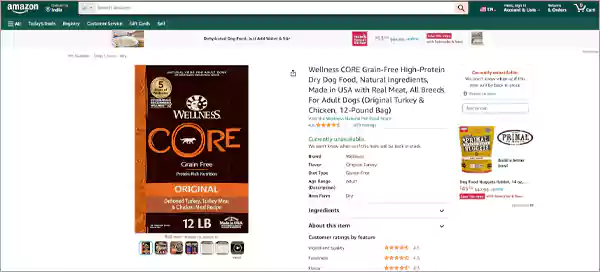
Have a Labrador but are not sure what to feed them? No worries!
Given the lively nature and fast metabolism of Labs, it’s essential to feed them a well-rounded, nutrient-rich diet to keep them at their healthiest.
Whether you’re looking for food for your German Shepherd or your Labrador Retriever, you must pick the right product. However, with so many options available on the market, it can be confusing to choose the best dog food for Labrador Retrievers.
But, don’t stress! We’re here to make it easier!
With lots of options out there, we’ll help you find the best food for Labrador Retriever, whether it’s dry or wet food. That way, your furry friend gets all the right nutrients for a happy, healthy life—without any fuss!

Known as “foodies” among dogs, Labradors have an incredible love of food, which is rooted in their history and biology. Driven by their role as hunting companions alongside humans, they depended on a lot of food to sustain energy during long days.
This inherent trait increases their intense appetite, often leading to overeating and potential weight problems. So, how they’re really into food reflects their inherent need for portion control and a balanced diet to ensure their well-being.
In short, the Labrador Retriever’s unwavering passion for food continues to be a defining characteristic of this breed, which requires careful attention to maintain a healthy lifestyle.
When selecting the best food for your Labrador, akin to searching for the best dog food for Goldendoodles, consider their age, activity level, and any specific health needs. Other than this, you need to—
Ultimately, you should prioritize a balanced diet tailored to your Labrador’s individual needs to ensure a healthy and vibrant life for him.
As just mentioned, choosing the best dog food for Labrador Retrievers depends on your dog’s nutritional needs, activity level, age, and any specific health concerns they might have. However, to assist you in the selection process or refine your choice, here is a list of the top 7 high-quality Labrador Retriever food from various brands that are often recommended for them—
Note: Each of these brands caters to different aspects of a dog’s nutritional needs, so you need to choose them according to your dog’s specific requirements and dietary preferences.

Specifically formulated to meet the nutritional needs of adult Labrador Retrievers, this food supports joint health, maintains a healthy weight, and contains precise levels of proteins, fats, and carbohydrates for the breed’s unique coat.
Moreover, it’s great for a Labrador’s jaws, helps them chew, and keeps their teeth healthy for a happy, energetic life.
In short, Royal Canin Labrador Retriever adult dry dog food includes antioxidants and essential nutrients to promote labs healthy skin, a shiny coat, joint health, and digestive support.
| Pros: | Cons: |
|---|---|
| The formula was adapted to the specific needs of Labrador Retrievers. | Contains some fillers and by-products. |
| It helps support healthy joints and weight management. | Some dogs may not like the taste. |

This formula is a versatile dry dog food suitable for active dogs of all life stages. It focuses on supporting performance and endurance with high-quality protein and essential nutrients. Basically, it provides a blend of nutrients and vitamins for overall health.
Additionally, this food helps maintain a healthy weight, strong immune system, and sustained energy levels. Most importantly, with a focus on nutrition, Purina Pro Plan Sport All Life Stages enables dogs to stay active and thrive at different stages of life, supporting their overall well-being.
| Pros: | Cons: |
|---|---|
| Good for active dogs and all stages of life. | Some formulas may contain grains that some dogs may be sensitive to. |
| It contains high-quality protein sources. | Variability in quality among different formulas. |

Tailored for large-breed adults, this food aims to maintain joint health and a lean body while supporting healthy digestion with a blend of antioxidants and omega fatty acids. It offers balanced nutrition for optimal growth, joint health, and a shiny coat. With just the right amount of calcium and phosphorus, it helps keep adult dogs’ bones and joints healthy.
Moreover, the size and shape of Hill’s Science Diet Adult Large Breed Dry dog food are considered best to support dental health and easy digestion of labs.
Overall, it’s a balanced diet that supports the health of large adult dogs with just the right nutrition for their size and activity levels.
| Pros: | Cons: |
|---|---|
| Tailored for large breed dogs. | Some dogs may not like the taste. |
| Supports joint and bone health. | Can be expensive compared to other brands. |
| Contains quality ingredients and balanced nutrition. |

Made with real roasted meat, fruits, vegetables, and antioxidants, this grain-free formula is inspired by a dog’s ancestral diet to provide balanced nutrition and support for your Labrador’s overall health.
Taste of the Wild High Prairie Grain-Free Dry dog food is made with real roasted meat and focuses on protein-rich sources such as bison and venison. This supports lean muscle development and energy in Labrador Retrievers. Additionally, its grain free formula suits dogs with sensitivities, while the mix of antioxidants, vitamins, and minerals aids immune function and coat health.
In short, this natural, nutritious food offers a tasty, well-balanced meal for your pet’s overall health and well-being.
| Pros: | Cons: |
|---|---|
| Grain-free formula. | There is potential for allergic reactions in some dogs to certain novel proteins. |
| Uses novel proteins like bison and venison. | Occasional reports of recalls for quality issues. |

Rich in premium proteins like turkey and chicken, it provides support for Labrador Retrievers’ strong muscles and energy levels. It’s grain-free with no artificial additives, but full of antioxidants, probiotics, and omega fatty acids for a balanced diet.
Wellness Core Natural Grain-Free Dry dog food promotes well-being while focusing on nutrient-dense ingredients to support a healthy coat, skin, and optimal energy levels.
Overall, this dog food focuses on natural ingredients for optimal nutrition and a healthy digestive system. Thus, making it an excellent choice for dogs wanting a wholesome, grain-free meal.
| Pros: | Cons: |
|---|---|
| Grain-free with high protein content. | It can be costly. |
| No artificial additives, colors, or preservatives. | Some dogs might not find the taste appealing. |

Known for its high protein content from quality sources like free-run chicken and turkey, wild-caught fish, and nest-laid eggs, this food is biologically appropriate for active breeds like Labradors. Basically, made to resemble a dog’s natural diet, it features high protein content sourced from different meats like chicken, turkey, and fish.
Moreover, being grain-free and packed with nutritious fruits, vegetables, and botanicals, Orijen Original Grain-Free Dry dog food promotes optimal canine health and vitality.
In essence, it is worth admitting that this food’s carefully selected, locally sourced ingredients offer a balanced diet that supports strong muscles, healthy digestion, and overall well-being for your beloved pet.
| Pros: | Cons: |
|---|---|
| High protein content from quality sources. | It is expensive compared to other brands. |
| Limited fillers and biologically appropriate ingredients. | Some dogs may find its taste too rich or strong. |

Crafted with real meat as the first ingredient, this one emphasizes wholesome grains, fruits, and vegetables, aiming to provide a balanced diet for your pet’s overall health and vitality.
If more to be mentioned, Blue Buffalo includes special antioxidants in LIFESOURCE BITS, created by holistic veterinarians. This unique blend supports healthy immune systems at every stage of your dog’s life.
Essentially, this formula uses natural ingredients and avoids poultry by-products, wheat, soy, or artificial additives to support your beloved pets’ vitality and immune system.
That’s why, there’s no wonder that by using tasty and healthy ingredients recommended by vets, Blue Buffalo becomes one of the popular choices for dog owners who want the best nutrition for their pets.
| Pros: | Cons: |
|---|---|
| It contains nutritious elements and antioxidants. | There are some reports of inconsistency in quality. |
| A variety of formulas for different needs and ages. | Occasional issues with recalls. |
Tip: Once you decide on the best dog food for your lab, monitor their response to the chosen food for digestive issues or allergic reactions. If there are any problems, gradually transitioning your Labrador Retriever to a new food can help prevent digestive upset.
Also, Check Out the Dr Marty Dog Food Reviews 2023
The most suitable dog food for Labrador Retrievers depends on how old they are. So, have a look at the best food for Labrador Retrievers determined by their age—

Newborn Labrador puppies primarily rely on their mother’s milk during this period. It’s essential to ensure the mother is on a high-quality, nutritious diet to support lactation. However, if the mother’s milk isn’t available, consult a vet for milk replacers or supplementary feeding formulas designed for puppies, such as Beaphar Lactol, Esbilac Puppy Milk Replacer, or Royal Canin Babydog milk.

Labrador puppies require a nutrient-dense diet to support their rapid growth. So, choose puppy-specific formulas rich in high-quality proteins, fats, vitamins, and minerals as best dog food for Labrador retriever puppies. For instance, Royal Canin Maxi Junior and Royal Canin Labrador Junior are popular choices. Additionally, there are puppy variants from other brands like Drools, Canine Creek, Orijen, and Acana tailored for junior and large breed puppies.

Adult or mature labs need a balanced diet that maintains their energy levels and supports overall health. So, look for formulas that offer a blend of proteins, fats, and carbohydrates suitable for their activity level. For instance, Royal Canin Labrador adult food is one option. There are also other high-quality brands like Farmina N&D, Hill’s, Orijen, Acana, and more to consider. Other than this, homemade meals can also be a healthy choice. You can also take into account weight management formulas if necessary and maintain a feeding schedule suitable for their routine.

Senior Labs typically have reduced activity levels and may develop age-related health issues. So, opt for senior-specific formulas that cater to joint health, such as those containing glucosamine and chondroitin. Moreover, note that foods with easily digestible proteins and controlled calories help manage weight and maintain muscle mass.
In that category, options like Royal Canin Size Health Nutrition, Wellness Core Senior Dog Food, Canidae Grain-Free Pure Meadow for Seniors, Halo Holistic Senior Chicken Recipe, Iams ProActive Health Mature Adult Senior Dog Food, Hill’s Science Diet, and Prescription Diet are available.
Note: You may also need to consult your vet for guidance on specific dietary adjustments for your senior Lab.
Read This Also: Sundays for Dogs Food Reviews
Here we’re highlighting the best dry dog food for Labrador Retrievers—
| Dry Dog Food | Key Features |
| Royal Canin Labrador | Formulated for Labs’ specific needs and joint support. |
| Purina Pro Plan SPORT | Balanced nutrients for active dogs support endurance. |
| Blue Buffalo Life Protection | Real meat, fruits, and vegetables for a balanced diet. |
| Taste of the Wild High Prairie | Grain-free, real roasted meat mimics a wild diet. |
| Eukanuba Labrador Formula | Joint support, weight management are tailored for Labs. |
Here we’re showcasing several best wet dog food options for Labrador Retrievers—
| Wet Dog Food | Key Features |
| Wellness CORE Grain-Free | High protein, grain-free foods, support a healthy coat and skin. |
| Merrick Grain-Free | Real deboned meat has no artificial preservatives or colors. |
| Blue Buffalo Wilderness | High-quality protein, no poultry by-product meals. |
| Hill’s Science Diet Adult | Balanced nutrition supports overall health and immunity. |
| Royal Canin Labrador Retriever | Specific formulation for Labs, supports ideal weight. |
Note: The best choice of food for your Labrador may depend on their individual needs, so you should also consult with a vet to determine the most suitable food for your pet. Additionally, combining dry and wet food or using them interchangeably can offer variety in their diet and provide different nutritional benefits.
On one hand, feeding dry dog food to your Labrador offers convenience, as it’s easy to store and helps maintain dental health by reducing plaque buildup while providing essential, balanced nutrition.
Wet dog food on the other hand, can be more palatable for picky eaters, offers extra hydration, and might benefit dogs with dental issues.
Note: Whether opting for dry or wet food, focusing on high-quality ingredients ensures your loyal furry companion gets the essential nutrients for a vibrant and active life.
However, as previously mentioned, combining both types can offer a balanced diet, provide variety, and meet different nutritional needs.
But you should always consult your vet to determine the best food combination based on your Labrador’s health, preferences, and specific requirements for optimal health and happiness.
Generally, feeding an adult Labrador Retriever twice a day is ideal to maintain their energy levels and prevent overeating. Puppies, on the other hand, may initially require three meals a day and will gradually move towards two meals as they grow.
When it comes to how much Labrador Retriever food to feed, know that the quantity varies depending on age, size, metabolism, and activity level.
A balanced diet typically includes 2-3 cups of high-quality dry food or a suitable amount of wet food per day, divided into meals. However, it’s crucial to adjust portions based on individual factors like weight, health, and lifestyle.
However, it is important to adjust portions based on individual factors such as weight, health, and lifestyle.
Of course, consulting your vet can also help you determine the best feeding schedule and portion sizes to keep your Labrador healthy and satisfied.
Before concluding, it’s important to note that certain foods pose serious risks to Labrador Retrievers and should be avoided. They are as listed—
Chocolate, grapes, raisins, onions, garlic, and macadamia nuts are highly toxic to dogs and can lead to severe health issues like kidney failure, neurological problems, or digestive distress.
Xylitol, commonly found in sugar-free products, can lower blood sugar and harm a Labrador’s liver.
Additionally, fatty foods or bones can trigger pancreatitis or choking risks.
Moreover, your dog should always steer clear of alcohol, caffeine, and foods with excessive salt or spices.
To sum up, it’s vital to keep these harmful foods away from your Labrador’s diet to keep them healthy and prevent potential emergencies.
Tip: Consulting your vet regularly also helps you stay updated on what foods could be harmful to your Labrador Retriever.
That’s all! Choosing the right food for your Labrador Retriever is a crucial aspect of their overall health and well-being. So, by considering their specific nutritional requirements, activity level, and potential health concerns, you can provide them with a balanced and tailored diet.
Next Read: The Farmer’s Dog Food Cost: Full Information on All Plans
Ans: The best food for Labrador dogs is a high-quality diet rich in protein and balanced nutrients. So, opt for high-quality proteins, balanced fats, and carbohydrates for your lab.
Ans: You should feed Labradors a mix of dry kibble and fresh foods like lean meats, vegetables, and fruits. Basically, look for formulas that suit their age, and activity, and offer joint support.
Ans: Labrador’s favorite foods often include meats like chicken or beef, but it’s essential to ensure a well-rounded diet for their health and well-being.
Ans: Well, serving sizes vary based on age, weight, and activity so follow feeding guidelines on the food package and adjust as needed. Moreover, you can consult with your vet.
Ans: Both dry and wet food can be beneficial to labs because, on one hand, dry food helps with dental health, wet food on the other hand, can add variety and moisture to their diet.
Ans: You can switch your lab food gradually over a week or two to avoid digestive issues. Also, you can do so if their nutritional needs change or if advised by your dog’s vet.
Sources:

Share